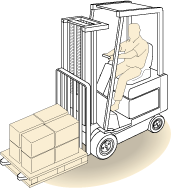Forklift Trucks— The Backbone Of The Industry The Baker Rauch & Lang Company developed and built a bomb-handli...
Forklift Trucks— The Backbone Of The Industry
The Baker Rauch & Lang Company developed and built a bomb-handling crane with a power lifting mechanism—the first electric lift truck. Designed to handle large artillery shells, these trucks represented the dawn of a new era and industry. 1915 (photo courtesy of Linde Baker)
A practical and popular machine for moving products over short distances is the lift truck, one of the most important, yet overlooked, industrial innovations in modern times. Today, over 150,000 of these machines are delivered to buyers each year.
Lift trucks evolved from hoists, which were the primary means of lifting and moving heavy items in the late 1800s. These hoists, essentially chains and winches, gave way to wooden platform trucks around the turn of the 20th century. Soon after, the wooden trucks and their trailers incorporated electric motors and traction batteries.
Around the time of the First World War, machines were designed with an electrical platform that could be raised or lowered. The war effort sprouted other new innovations, including a bomb-handling crane with a power lifting mechanism, considered to be the first electric lift truck.
Early lift truck models were quite simplistic, with no hydraulics or even forks. These early pieces of equipment were designed to lift a load only a few inches, so chains and elbow grease were usually enough to move a load laterally a few feet. Even with the limited lifting capacities, these machines made the unloading and loading of freight much easier and more efficient, which became even more necessary during the labor shortage caused by the war.
What is generally credited as the forerunner of the seated counterbalanced truck was produced by Clark in 1917. Known as a Tructractor, it was originally developed solely for use in Clark's axle plant, but visitors saw its practicality and requested their own models. Then in 1920, the first industrial truck to use hydraulic power to lift its load was introduced. In 1923, Yale produced the first electric truck with raising forks and an elevated mast, today considered the first fork lift truck. The lift worked via a ratchet and pinion system.
The new forklift trucks did not immediately surge in popularity, but a major breakthrough occurred upon the development of the standardized pallet in the late 1930s. The pallet allowed loads to be stacked uniformly and led directly to the increased development of the forklift.
World War II was another major catalyst in the development of the forklift truck, as laborers needed a more efficient way to load the vast quantities of war goods onto the numerous wagons and ships. One company's shipments increased from 500 units in 1939 to 23,500 units during the later war years. The continual movement of goods throughout this period also made it necessary for the electric trucks to last longer, and models were developed that could work a full eight-hour shift without needing to be recharged.
By the 1950s, it became clear that more efficient storage methods were needed, and warehouses began to expand upward rather than outward. Thus, more powerful and more maneuverable forklifts were required. New models could fit into narrower aisles and lift materials up to 50 feet above the ground, higher than ever before. Narrow aisle forklifts helped revolutionize the warehousing industry, as more shelving could be placed into the same space.
With the increased lift heights came legitimate safety concerns. Objects that fell from those heights could very easily injure lift truck operators. By the late 1950s and early 1960s, forklift manufacturers began to offer options for load backrests and operator cages. These items eventually became standard, and issues of forklift safety have not gone away. Operator restraint systems were made standard in the early 1980s, and forklift safety remains an important engineering concern today. New developments in truck and load balancing technology keep vehicles from tipping over.
In addition to safety innovations, lift trucks are changing in other ways. Environmental and emissions concerns have led to the development of different types of engines. Power sources for trucks continue to evolve from battery power to electricity to propane to compressed natural gas, among others. Hydrogen fuel cells are on the horizon, and in 2000, a prototype was constructed using fuel cells as a source of driving power in a forklift truck.
The forklift has come a long way since those early chains and winches, with technology a driving force behind continued innovation. The future surely will hold more evolution, and it will be up to the members of MHEDA and the industry to lead the way down that path.







 粤公网安备 44010602003952号
粤公网安备 44010602003952号